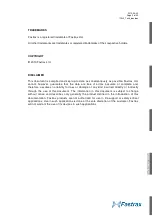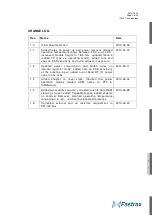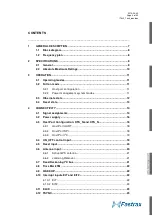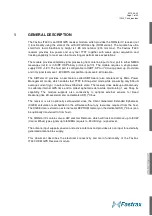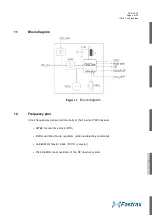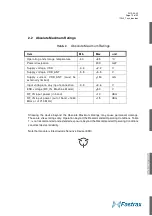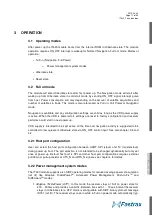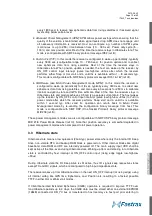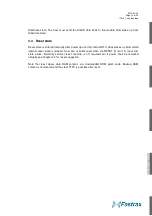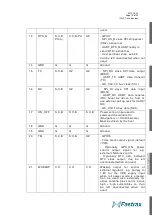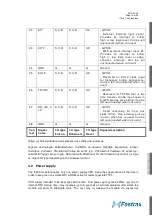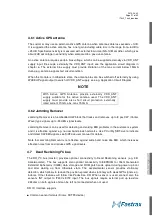
2010-06-30
Page 12 of 42
IT430_Tech_doc.doc
every 1800 sec) to receive new ephemeris data from rising satellites or if received signal
levels drop below certain level.
2.
Advanced Power Management (APM)
: APM allows power savings while ensuring that the
quality of the solution is maintained when signal levels drop. APM does not engage until
all necessary information is received. Host can configure e.g. number of APM cycles
(continuous or up to 255), time between fixes (10… 180 sec), Power duty cycle (5…
100%) and max position error. Rest of the time the receiver stays in Hibernate state. This
mode is configurable with SiRF binary protocol message ID53 (
ref III
).
3.
Push-to-Fix (PTF)
: In this mode the receiver is configured to wake up periodically, typically
every 1800 sec (configurable range 10… 7200 sec), for position update and to collect
new ephemeris data from rising satellites. Rest of the time the receiver stays in
Hibernate state. When position update is needed, the host can wake up the receiver by
ON_OFF control input interrupt (pulse low-high-low >90us after which the receiver
performs either Snap or Hot start and a valid fix is available within 1… 8 seconds typ.
This mode is configurable with SiRF binary protocol message ID151 & 167 (
ref III
).
4.
SiRFAware (
aka
Micro Power Management
mode
, MPM)
: In this mode the receiver is
configured to wake up periodically for 18 sec, typically every 1800 sec, to collect new
ephemeris data from rising satellites, and also every 60 seconds for 250 ms to calibrate
internal navigation state and GPS time estimate. Rest of the time the receiver stays in
Hibernate state and module achieves 0.5 mA typ. average current drain. The host wakes
up the receiver by ON_OFF control input interrupt (pulse low-high-low >90us) to
Full on
power mode after which the receiver performs Snap start and a valid fix is available
within 1 second typ. After valid fix, operation can return back to
Micro Power
Management
mode by re-sending the configuration binary message from host. This
mode is configurable with SiRF OSP (One Socket Protocol) binary protocol message
MID218 (
ref III
).
These power management modes are also configurable with SiRF OSP binary protocol message
MID 218, Power Mode Request (
ref III
). Note that position accuracy is somewhat degraded in
power management modes when compared to full power operation.
3.3 Hibernate state
Hibernate state means a low quiescent (20uA typ.) power state where only the internal I/O Keep
Alive, non-volatile RTC and backup RAM block is powered on. Other internal blocks like digital
baseband, data RAM and RF are internally powered off. The main supply input VDD shall be
kept active all the time, even during Hibernate state. Waking up from and entering in to Hibernate
state is controlled by host interrupt at ON_OFF control input (rising edge toggle low-high-low
>90us).
During Hibernate state the I/O Keep Alive is still active, thus I/O signals keep respective states
except TX and RX signals, which are configured to high input impedance state.
The receiver wakes up from Hibernate state on the next ON_OFF interrupt (at rising edge) using
all internal aiding like GPS time, Ephemeris, Last Position etc. resulting to a fastest possible
TTFF in either Hot or Warm start modes.
If Client Generated Extended Ephemeris (CGEE) operation is required to improve TTFF over
long Hibernate periods up to 3 days, the CGEE data must be stored either on external EEPROM
(128kB) connected at DR_I
2
C bus or transferred to host memory via host port prior entering to
Содержание IT430
Страница 24: ...2010 06 30 Page 24 of 42 IT430_Tech_doc doc Figure 3 Dimensions ...
Страница 38: ...2010 06 30 Page 38 of 42 IT430_Tech_doc doc 7 3 Circuit drawing ...
Страница 39: ...2010 06 30 Page 39 of 42 IT430_Tech_doc doc 7 4 Assembly drawing Top side 7 5 Artwork layer 1 Top ...
Страница 40: ...2010 06 30 Page 40 of 42 IT430_Tech_doc doc 7 6 Artwork layer 2 7 7 Artwork layer 3 ...
Страница 41: ...2010 06 30 Page 41 of 42 IT430_Tech_doc doc 7 8 Artwork layer 4 Bottom ...


